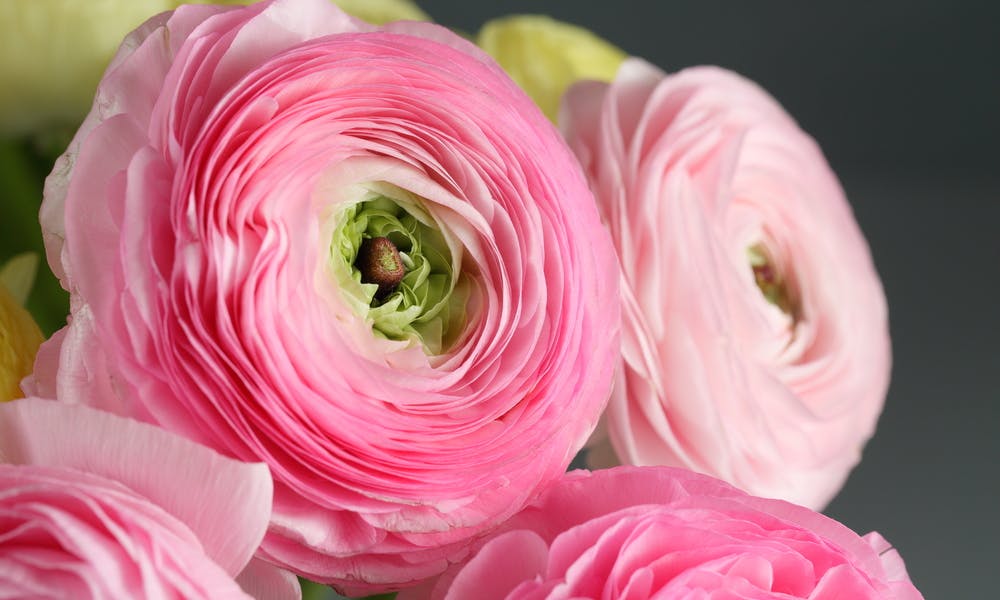MENU
Ranunculus flower

The ranunculus is a bulbous perennial appreciated mainly by gardeners. Its generous spring-flowering brightens terraces and gardens with stunning hues until the beginning of summer. Easy to live and grow, the flower particularly likes shaded areas around the Mediterranean but finds its place in most gardens.
The ranunculus gives us its sublime flowers from the first frost of winter until spring. Its flowering, both wealthy and refined, makes it a popular choice for bouquets and floral arrangements.
Today, in this article, we are going to discover its secrets and our tips for maintaining it.
- Main characteristics
- Different varieties
- A bit of history
- Symbolism
- Cultivation and care
- Planting ranunculus in the garden
- Interesting facts about the flower
Main Characteristics
The Ranunculus, also known as ranunculus asiaticus or the Persian buttercup, is a popular and valued flower. It is a perennial herb belonging to the family, Ranunculaceae. The flower originally comes from the Mediterranean and south west Asia. It is resistant to temperatures up to – 10 ° C and is perfectly suited in a pot. The beauty of its flowers makes it indeed very popular with florists and customers, alike.
The buttercup belongs to the genus Ranunculus, comprising about 400 species, which includes, in particular, the Golden Button. Ranunculus, derived from the Latin word ‘rana,’ meaning “little frog.” This refers to its natural habitat. The flower likes muddy and marshy areas. The florists’ buttercup’ is the source of all the hybrids.
The Ranunculus stands proudly up to 45 cm in height, at the top of a thin, rigid stem. Its numerous tuberous roots, slightly curved, are called “claws” as in lily of the valley.
Different Varieties
Today, many varieties have developed to offer a wide range of sizes, shapes, colors, and flowering periods. It blooms from winter to spring. The Asian buttercup, “Pauline Violet,” has a magnificent purple flowering, which appears early in May. Medium in size, it reaches about 40 centimeters tall in the adult stage.
Some small-sized varieties form the shades of harmonious colors, such as “Mignonette” and “Accolade.” These dwarf kinds do not go unnoticed.
The Ranunculus is a flower that lends itself particularly well to flower arrangements. They form bouquets of beauty, thanks to their single or double flowering. Orange, yellow, white, pink, or red, in color, they offer many possibilities to decorate your home.
A Bit of History
The ranunculus was first discovered in the 13th century in the Holy Land by the first Crusaders of Saint-Louis (Louis IX). But at this time in Europe, the flower had gone almost unnoticed. A few years later, the bulb drew attention in the gardens of the rulers of the Ottoman Empire.
In the 17th century, it was found in the gardens of Sultan Mohammed IV. Thus, the flower achieved great success and a worldwide reputation.
Symbolism
In the language of flowers, the ranunculus is the flower of seduction, charm, and beauty. The flower is viewed as a compliment, loudly proclaiming, “you are charming.” For instance, a bouquet of red ranunculus shows physical attraction. However, a bouquet of pink ranunculus represents attraction mixed with timidity.
The ranunculus means “you are divine,” “You are radiant and charming,” “you are dazzling,” “you are brilliant and attractive,” “you are full of charm,” and this can go as far as “your body is lovely.”
Depending on the color, the ranunculus can symbolize accusations and criticisms, too, though, so be careful!
Cultivation and Care
We all wish to have beautiful ranunculus flowers at home. It would be best if you kept in mind that the ranunculusis not easy to plant. However, the following tips can help you greatly in this regard. You can grow potted ranunculus for your home or make room for them in the garden.
Ranunculus prefers soil rich in humus and nutrients, and should be exposed to the sun. It appreciates a slightly moist bed. The potted ranunculus should have a good quality potting soil.
Make sure to find a place for them in your house where it is cool, between 10 and 14 ° C. Water your plant regularly, making sure that water does not stagnate in the saucer or plant pot. Once the risk of frost has passed, place it in a partially shaded area outside, for example, on a balcony.
Planting Ranunculus in the Garden
In the garden, the ranunculus likes to be around the borders, and again, they need good quality soil, so fertilizer might be required.
Expose them to partial shade. Depending on the region where you live, plant your ranunculus plants once the risk of frost has passed, typically between February and April.
Do not hesitate to vary the colors to create beautiful beds! In the case of a lot of sunshine, add a little wet straw. Water the plants from time to time to keep the soil a bit moist. If all goes well, your ranunculus should bloom about two months after planting.
Interesting Facts about the Flower
In the language of flowers, ranunculus represents charm. In the Victorian era, offering ranunculus was a way of saying, “I find you physically attractive.
Each country also names its ranunculus. We have the Persian buttercup, Dutch, French and Scottish. They are all buttercups, and they belong to the same plant family.
This flower plays the leading role in a known Iranian legend, too, where a shy prince didn’t dare to show his love to a beautiful nymph. Heartbroken, he dies and turns into a ranunculus, which hides its secret in its petals.
Red, pink, orange, yellow, white, blue, and purple, all these colors are associated with the beautiful ranunculus flower. The flower is available in all sizes and shapes, and even as a single flower, semi-double, or double flower. The plant grows from irregularly shaped tubers, also called claws. Potted buttercups bloom from early March to late April. Even after flowering, they are still beautiful.

